Breitling Watches: The Resurgence and the Georges Kern Effect
by Raman Kalra
Raman Kalra is the founder of The Watch Muse blog and has kindly agreed to share some of his articles with us here on Quill & Pad.
___________________________
Breitling needs no introduction. Just on hearing the name I am sure you can already picture their watches, that is how strong their reputation and design personality is.
Breitling is one of those brands with an extremely loyal fanbase and they have produced some of the most well-known watches ever, such as the Navitimer and Emergency. Despite this, they are still positioned to capture even much broader demand given their unique design language and pricing.
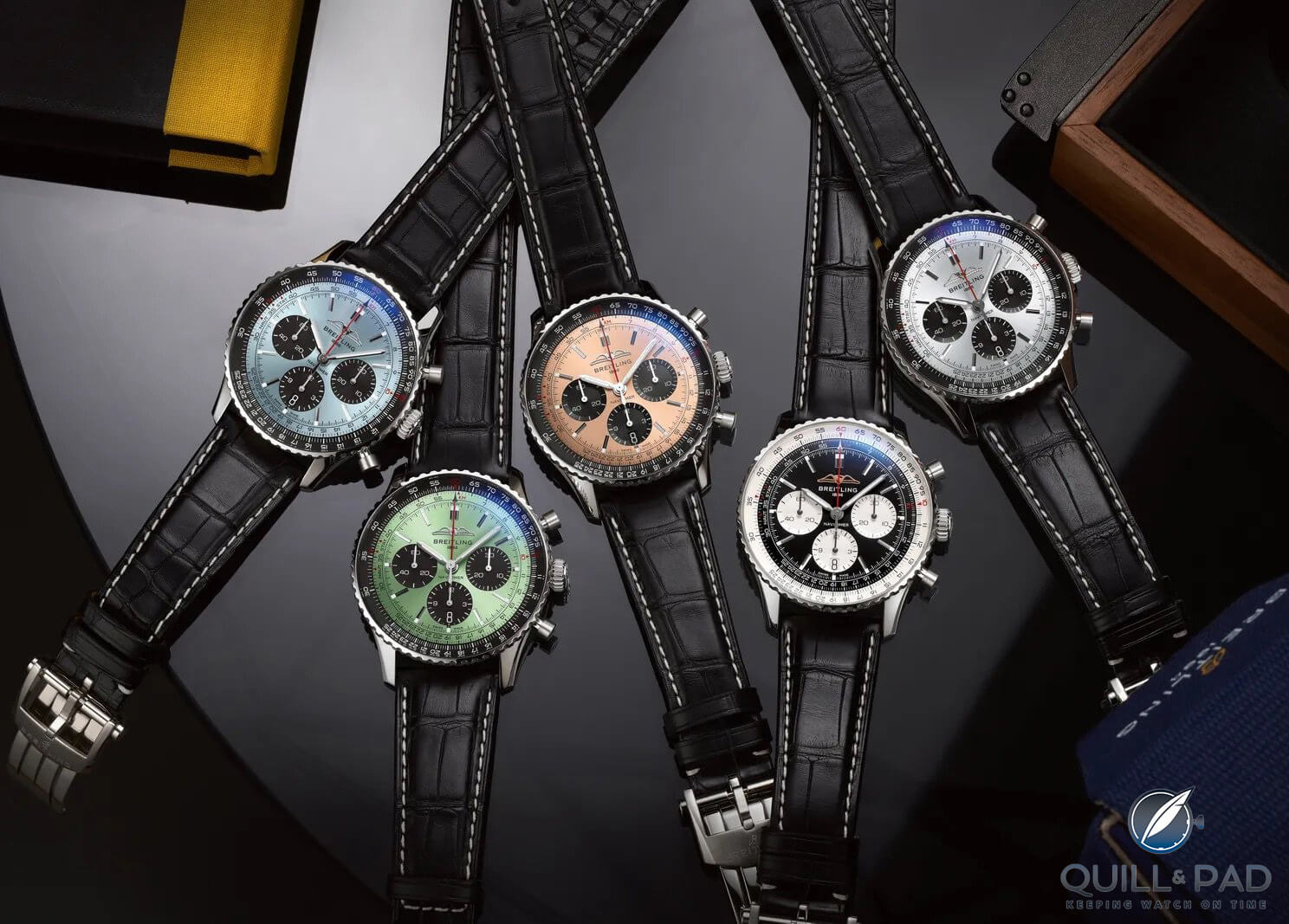
Breitling Navitimer collection
However, being one most recognizable watch brands does not mean that Breitling has not faced challenges, and the most recent came prior to 2017. The brand was struggling both with internal and external headwinds. Internally, there was a lack of direction, and externally they were up against stiffer competition, market trends, and consumer demands.
Thankfully, under the leadership of Georges Kern and a capital injection from CVC Capital in 2017, this has turned around.
In 2022, Breitling entered the top 10 Swiss watch brands by sales revenues according to Morgan Stanley. Below is my take on how this has been achieved. It is nice to know that I am not the only one drawn to their more recent releases!
History
Before we consider Breitling in the present, we need to look at its past to appreciate just how rich its history has been. This is always useful in setting the context as watches are emotive products, and a lot of what drives the desire for a watch or brand comes from what they represent. Breitling started in 1884 when Leon Breitling opened his first atelier in Switzerland. The focus for him and the brand was chronographs, and this is where they found success. They were widely used and managed to create innovations that are still relevant today.
In 1893 Breitling produced a movement with an 8-day power reserve, as well as the Pulsograph used by doctors to read heart rates.
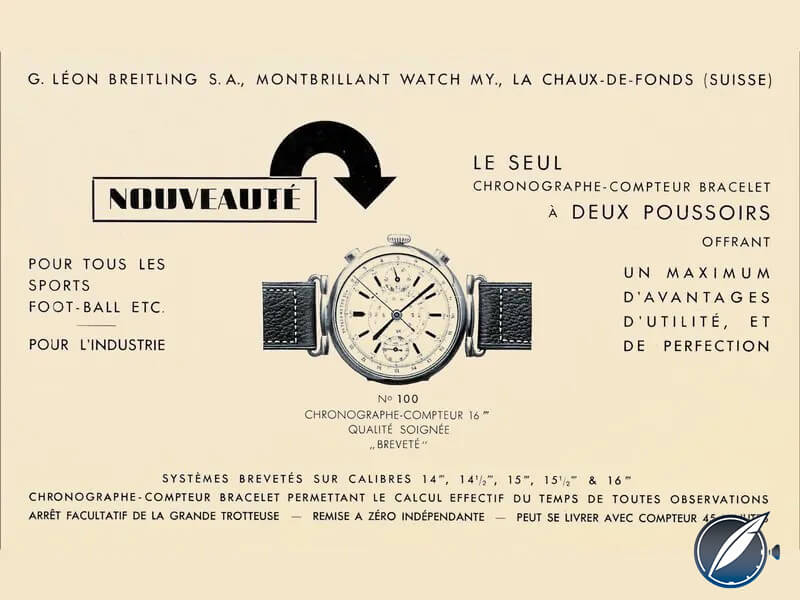
1934 Breitling advertisement for two-pusher chronograph
Following this, in 1915, Breitling moved the chronograph start/stop pusher away from the crown to 2 o’clock, and in 1934 the reset function to 4 o’clock. This helped prevent any inadvertent pushes, improving accuracy and ease of use. Breitling had created the blueprint for nearly all future two-pusher chronographs.
From here, the 1930s and 1940s Breitling were all about building the brand identity we know today. Willy Breitling, in charge from 1932, could sense the importance of aviation and focused on producing cockpit instruments. Beyond this, innovation was still rolling and they developed and introduced the logarithmic side rule wristwatch in 1940, which enabled mathematical operations to be calculated.
In this period we start seeing some of the ranges we have come to know with some still being in the collection today e.g. the Premier in 1943.

Breitling advertisement from the 1950s
With the brand identity now formed, it was the 1950s that saw the brand expand outside the military.
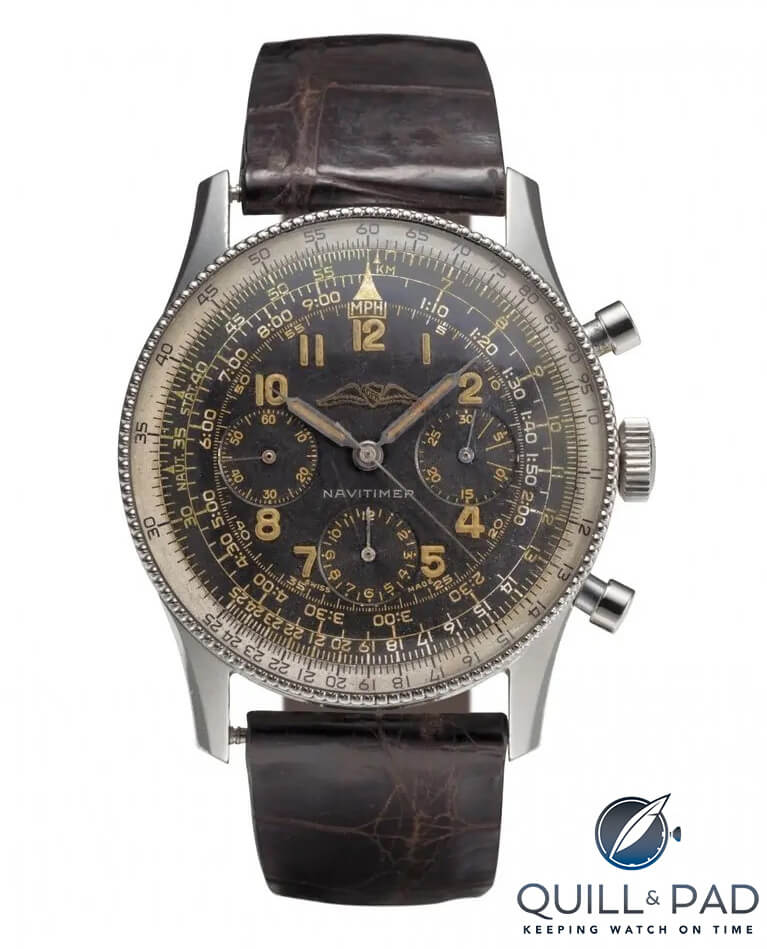
1954 Breitling Navitimer
Most notably, 1952 saw the introduction of the Navitimer – a combination of navigation and timer – it was sold to civilian pilots as a tool allowing them to perform all necessary calculations for flying. Initially, it was only sold to members of the Aircraft Owners and Pilots Association (AOPA), but it was so successful it was rolled out to the public.
There were other additions to Breitling such as the Co-Pilot chronograph, but the next big step came in 1957 with the launch of the SuperOcean.

Vintage 1950s Breitling SuperOcean
It is possible that the development, competition, and demand for other dive watches of the time contributed to the brand’s decision to shift focus toward the ocean. Breitling struggled with the Quartz Crisis like the majority of Swiss brands. Ownership changed and, under the helm of Ernest Schneider, Breitling embraced quartz as it provided the necessary precision for pilots. This produced the “Instruments for Professionals” tagline.
At the same time, Breitling continued to produce mechanical watches, and for its 100th anniversary, it released the Chronomat. A large mechanical watch, completely opposite from the market trends, yet it was very popular.
However, while Breitling found success in new areas, without a doubt their recognition came from the aviation-focused chronograph watches.
Breitling’s Challenges
Breitling has a long history and a claim to some great achievements in the world of watches. It overcame the quartz crisis under the new leadership of Ernest Schneider, a Swiss soldier and previous head of Sicira (a small watch company), as well as playing a pivotal role in the resurgence of mechanical timepieces.
Despite this, Breitling still faced a combination of few difficulties rather than one particular challenge. Pre-2017, there was a mix of factors, both internally and externally, that went hand in hand negatively affecting Breitling. This led to a steady demise in terms of both collector interest and sales.
Those who viewed the Breitling website back in those times or were following the brand closely would know that Breitling had a very complicated collection. Not complicated in terms of movements, but from a consumer point of view. There were too many models to choose from. Chrono24 lists 604 unique for sale from 2007-2016! And these are in at least 11 distinct collections.
Giving consumers choices is usually positive, but this went above and beyond, with many different dial options (colors and configurations), complications, and sizes. Managing to keep the story and emotion behind watches is tough at the best of times, especially for the less well-known models. Doing so for over 600 references is nearly impossible.
And there were other issues, namely brand direction. On one hand, you have the staples of the collection such as the Navitimer, SuperOcean, and Emergency, but on the other, you have the For Bentley and Transocean models.
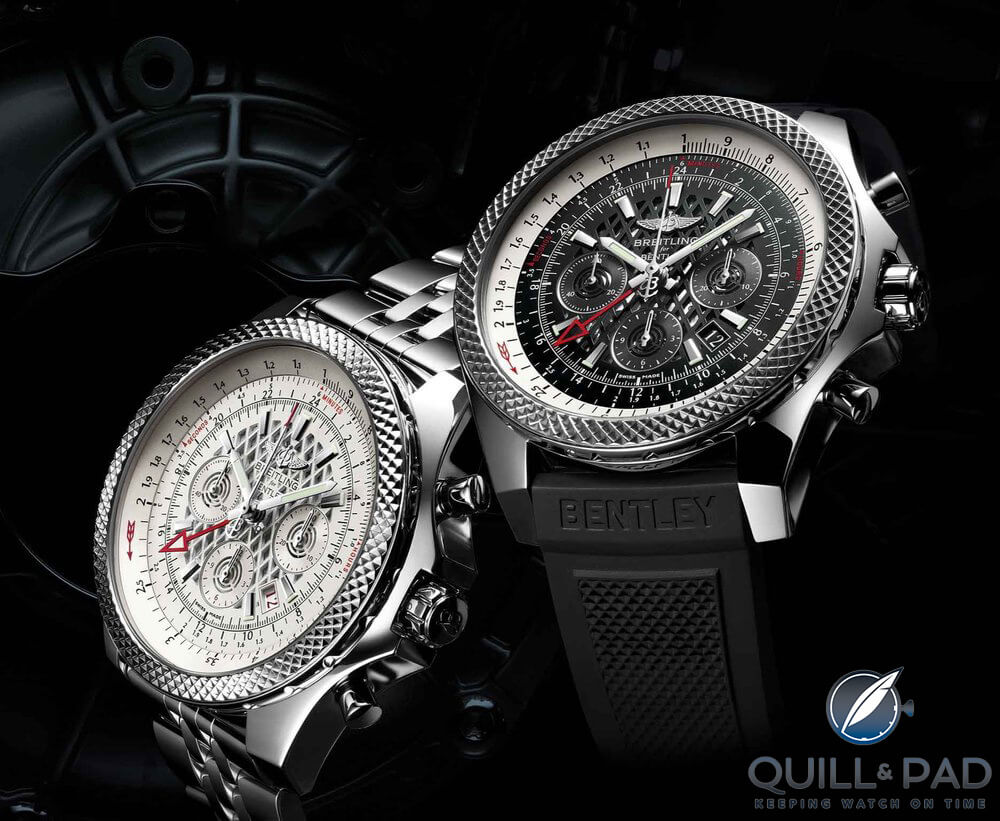
Breitling for Bentley GMT
Then within these collections, the design varied. This is not a knock on any model, more to highlight that design consistency and language were confused, and focus was not aligned (I have no knowledge of what was happening internally, but this is my impression from the outside).
Take the Transocean range as an example. Under this naming from 2007-2016, you could find vintage-inspired chronographs, a world-time chronograph, a day-date time-only, and a moonphase chronograph. It may not sound like a lot, but what it comes down to is design inconsistency.
Breitling complicated the messaging which confused the potential clients, and that’s not ideal when you are selling an emotive product.
And outside of Breitling, broader watch trends were shifting.
The most important comes down to sizing. As we discussed in my Watch Trends article, there has been a shift in demand from larger-diameter timepieces to those that are more wearable. Given that Breitling focused heavily on pilots’ watches, the brand’s average size offered tended to be (very) large. Panerai also faced a similar predicament, although they specialize in large dive watches.

Breitling case sizes 2018 compared to 2023
By looking at the trends, the watch sizes that seem to be the most produced are between 41-43mm. If we compare this to what Breitling was offering, we can see that between 2007-2016 the highest proportion of their watches on sale was 44mm.
Breitling’s next highest size category was 43mm and 46mm. Interestingly, 9% of all Breitling watches at this time were 48 mm, which is nearly double the general brand average percentage of over 47mm diameter watches.
Breitling obviously catered to an audience that preferred these larger pieces. But it was not just size preferences that were shifting, it was also aesthetics. Looking at the majority of Breitling watches pre-2017, they are very busy. Many may have been just a chronograph with three sub-dials, but the look was complicated by the sizing of the sub-dials, the size of the indices, and the use of minute markers and Arabic numerals.
On top of this, Breitling watches were (and still are to a degree) highly polished and therefore, can be considered more ostentatious – think of its For Bentley range. There is always demand for this style of watch and some fit under their “Instruments for Professionals” tagline and aviation theme; however, tastes were changing. You saw the fashion shift towards vintage watches.
There was an uptick in the interest in vintage watches, but also demand increased for new watches that were vintage-inspired. The best example of this was the launch of the Tudor Black Bay and its subsequent success.
Separately, the use of fauxtina on watches became more prevalent, and the first mention of the word came around 2012. These watches brought a new wave of simplicity. By being inspired by what came before, when watches were truly used as tools, a lot of the excessive styling was removed.
Before you say it, I get it: the Navitimer has always looked complicated, but that spread to the rest of Breitling’s collections.
It is easy to see now why Breitling was facing headwinds. The brand has such a history and presence that it needed to be turned around, and thankfully, that is what happened in 2017.
The Turnaround and the Georges Kern Effect
The turnaround began when the private equity firm, CVC Capital, bought an 80% share in Breitling for €840mn in 2017.

Breitling CEO Georges Kern
The news was followed by the announcement that Georges Kern would be joining with a new management team, and interestingly, Kern took a 5% stake for himself. He was previously the CEO of IWC and was on the Richemont board and head of specialist watchmaking.
Following this, changes to the brand began and now looking at the past six years we can fully appreciate the effect they had. The strategic shift was driven by four main categories: simplification, sizing, image, and marketing.
Simplification
As mentioned in the previous section, Breitling faced a big issue of over-complication with its collection and aesthetics. Focusing on the collection, there were 604 unique references for sale on Chrono24 when filtering for 2007-2016. Obviously, this can vary slightly depending on what is listed at the time of viewing, but this figure has been confirmed by Forbes, which mentioned that Breitling had “over 600 product lines” pre-2017.
The simplification process was not just about cutting references but refining the pillars of the collection and the references within them.
Previously, Breitling was aviation focused yet had the SuperOcean, Chronomat, Transocean, For Bentley, etc. and you didn’t really know where they fit within the brand.

Breitling: Land, Sea and Air core collections
This was streamlined into three core collections: Air, Land and Sea. Air contained the Navitimer and Professional, Land the Chronomat, and Sea the SuperOcean.
The other ranges such as SuperOcean Heritage were all categorized into these three groups, and as time has progressed and new models released, then collections have expanded. This change allowed Breitling to have a clearer narrative around each group and a clear view of what the watches represented. This gave the consumers a better understanding of the overall collection and Breitling the opportunity to move some focus away from aviation to build out other areas.

Breitling Superocean Automatic 42 mm
From here, the simplification then resulted in trimming the number of references on offer. The aforementioned Forbes article cites that the number dropped from 600 to 150. Looking at the Breitling website in April 2023, the total number of watches available is 289. This is a big drop and ultimately improved the product offering.
Then within the product lines, the overall aesthetic of the watches was also simplified. This resulted in the new watches being known as “Modern Retro”. Let us consider some of the main examples of this.
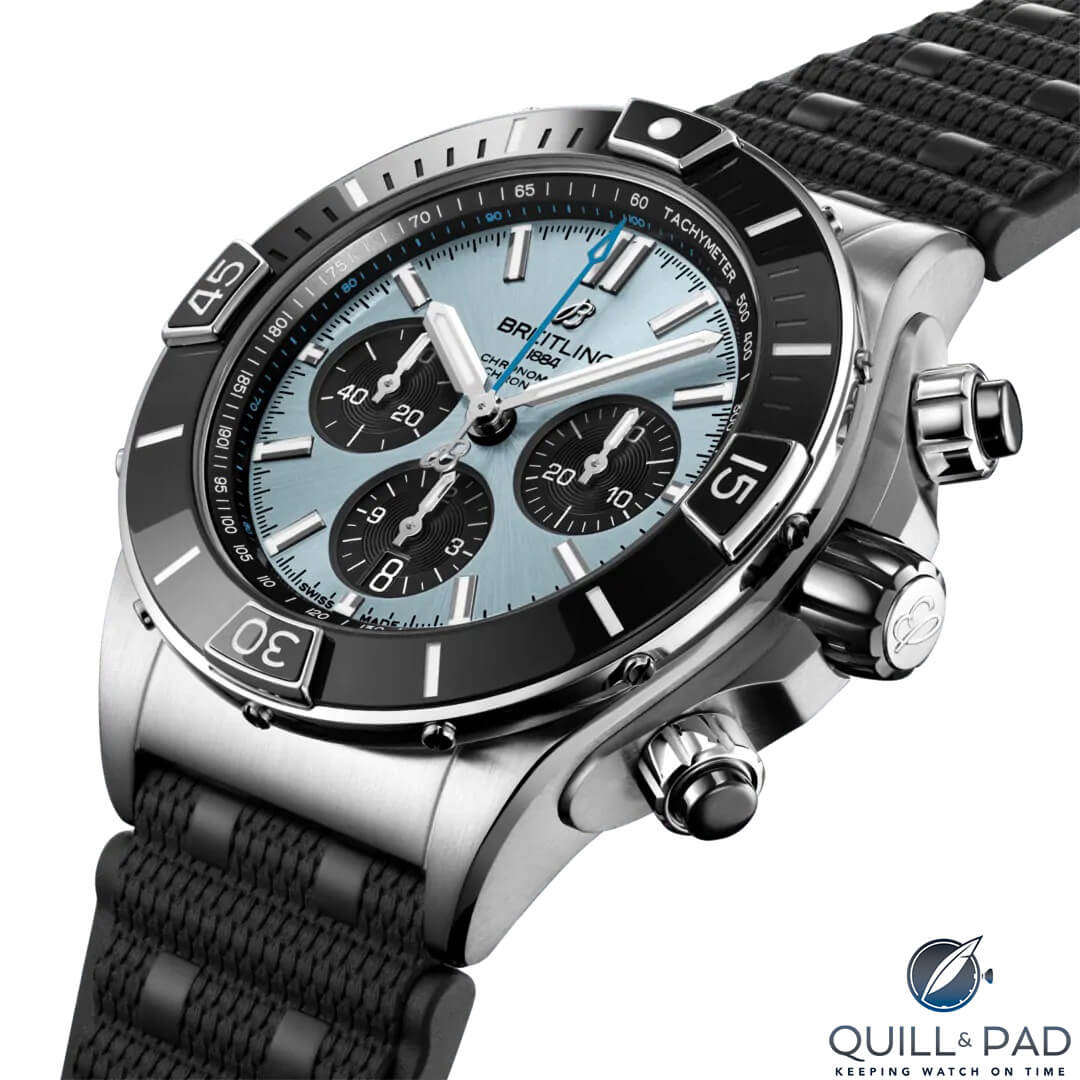
Breitling Super Chronomat 44 mm
First, the Chronomat. The update to the Chronomat range in 2020 saw Breitling bring back the famous “rouleaux” bracelet, a beautifully unique bracelet that captures the essence of Breitling. The dial became much cleaner on the chronograph, and a time-only variant was added. The dial gained a sense of space and cleanliness. The watch suddenly became much more versatile, opening up to new customers and fitting nicely into the “Land” category.
Breitling even tackled its most renowned model – the Navitimer. This came in 2022 with updates to the movements, size, and color options (more on this later). On the dial though, the aim was to keep the watch feeling as much like the original as possible, so Breitling kept the defining slide rule feature but removed the tachymeter. A bold move, yet it works and has made the Navitimer more broadly appealing.
Sizing
The subject of sizing goes somewhat hand-in-hand with the idea of simplification. As Breitling de-cluttered the overall collection and reduced references, the focus was on offering fewer designs but with more sizing options. Breitling was aware of consumer demands trending to smaller timepieces and started to make a change.
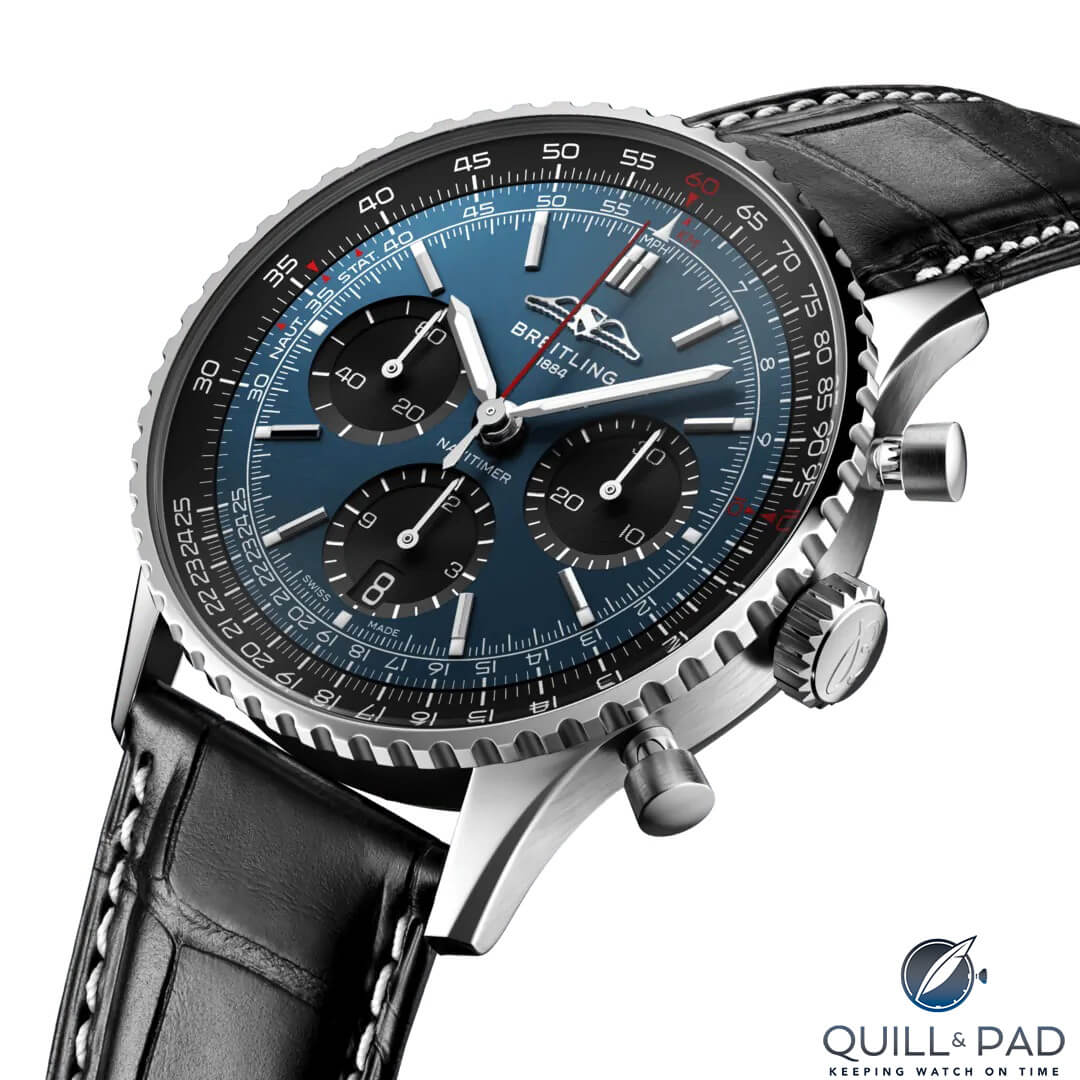
Breitling Navitimer chronograph 41 mm
The new Navitimer launched in 2022 is offered in three different sizes: 41 mm, 43 mm and 46 mm. However, if we look at how many references are offered for each, there are sixteen variants in 41 mm, seven in 43 mm, and four in 46 mm. This is a clear shift smaller in even the most iconic model that was historically at the top of the size range.
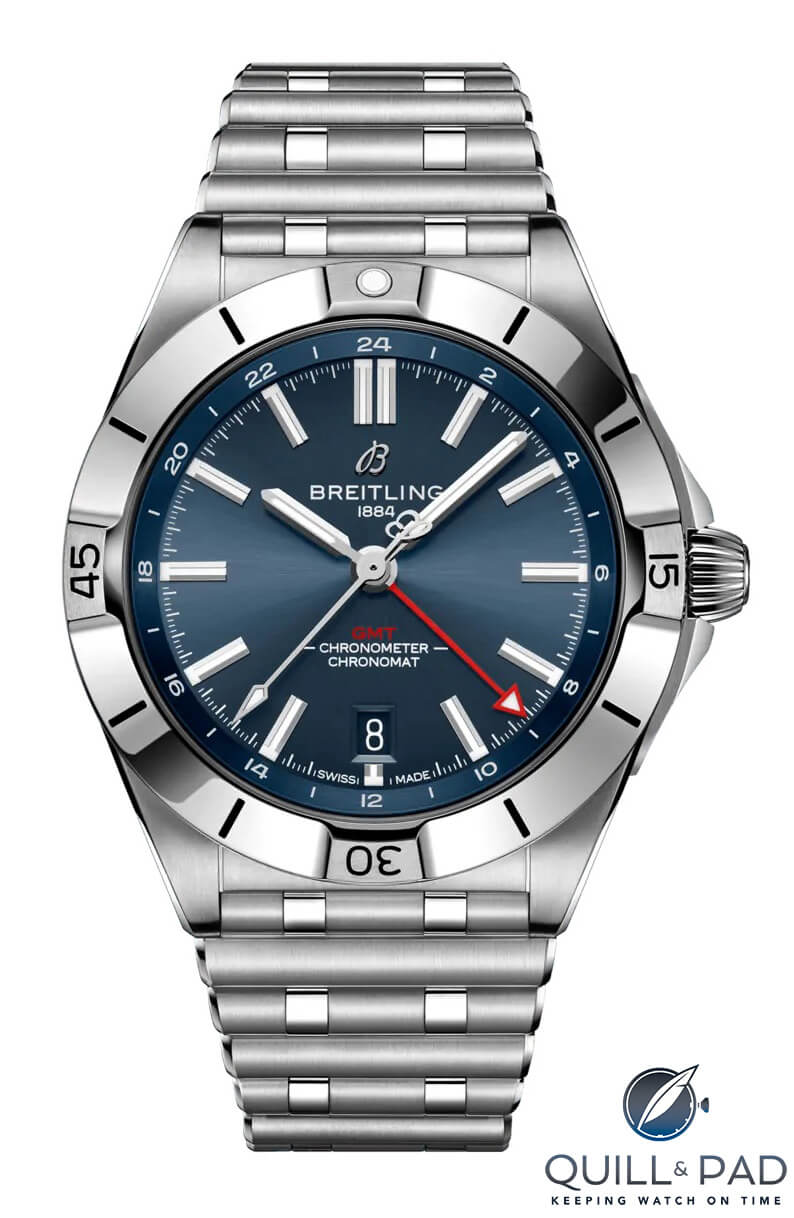
Breitling Chronomat Automatic GMT 40 mm
This has been seen to the same extent with the Chronomat coming in 36 mm, 40 mm, and 42 mm.
Equally, the SuperOcean experiences the same thing, and the majority of references are found in the smallest 42mm size (rather than the 44mm or 46mm that are also offered). You can clearly see the trend, especially with these completely refreshed models.
The final point to make here is that a big component of Breitling’s strategy has been the realization that women are a large consumer demographic of luxury watches, and this was an area where they had not focused on much previously.

Breitling Super Chronomat Automatic 38 with diamonds
There is a reason the 36 mm Chronomat is offered in lighter dial colors with diamond options. To try and help visualize this, if we compare the figures found earlier for those watches produced between 2007-2016 on Chrono24 compared to the range 2018-2023, we can see this repositioning.
The majority of Breitling’s watches are still found at 44 mm, however, the difference comes on either side of this. For the prior period, watches 45-48 mm accounted for 31%, whereas that has now dropped to 18% these last few years. Likewise, the proportion of watches 43 mm and below grew from 42% to 58%.
This has all resulted in more wearable watches for a broader set of consumers and is helping bring renewed interest to the brand.
Image & Marketing
The final two components of the turnaround are image and marketing. With consumer demand shifting towards vintage-inspired pieces during the 2010s, Breitling needed to address this and created the concept of “Modern Retro”. This means combining the best of their past watches with a modern twist.

Breitling Superocean Automatic 44 mm
The SuperOcean does this perfectly, taking inspiration from the 1960s SuperOcean Slow Motion with the white minute track, but being modernized with bright colors. By doing this, it combined the modern and retro perfectly and fit with the simplification of aesthetics, resonating with consumers.
Breitling brought back other pieces from its back catalogue such as the Top Time and Premier in the same vein. However, image does not just relate to the end products but rather the whole brand right down to the logo. Breitling changed their logo to reflect their new path by removing the wings around the iconic “B” and using a more modern font for their name.
Breitling also removed the slogan “Instruments for Professionals”, now kept solely for the Professional range. This subtle change helps convey that they are no longer focused purely on aviation but are looking broader (Air, Land, Sea).

Breitling boutique
At the same time, Kern looked at the boutiques as an opportunity to project their new image and heavy investment went into renewing them. They now have a relaxed feel, typically designed with exposed brickwork, aged leather and some touches of the famous Breitling yellow. They look more like a mix between a nice apartment, bar and fashion store.
Yes, it projects a fresh new vibe and modernity, yet the intelligent part is that they feel relaxed.
Typically, the watch industry has been associated with snobbery, but Breitling went a different direction hoping to entice more people to feel welcome to enter and experience what they have on offer. This was very well timed as it coincided with society becoming more relaxed. Suits and ties in the city are becoming less common, sneakers and streetwear are becoming more prevalent, and watches are becoming more vibrant and less serious/formal looking.
The Air, Land, and Sea concept has also fed through to its marketing where Breitling has created “squads” for each. These squads are made up of celebrities and professionals from different areas that typically are at the top of their field. These names include Giannis Antetokounmpo and Charlize Theron as well as individuals like Scott Kelly who spent a year on the International Space Station.
This allows for different angles to be explored by Breitling when using these endorsements. Furthermore, they are exploring different channels of marketing, namely webcasts called Breitling Summits. These take an in-depth look at models, discuss their history and story, and feature Georges Kern himself. I would recommend taking a look if you haven’t.
Buying a luxury watch comes down to emotion and narrative and Breitling is doing a good job at conveying this, regardless of how you feel towards their ambassadors.
The Result
What is the result of all these changes? A steady resurgence of Breitling and in 2022, according to Morgan Stanley, they are now in the Top 10 Swiss Watch Brands by revenue and units sold. Between 2019 and 2021, Breitling revenues jumped 55% to $730 million, and in that same time, the number of units sold increased by 50,000. Clearly, this has moved up again in 2022 given the brand gained an extra rank.
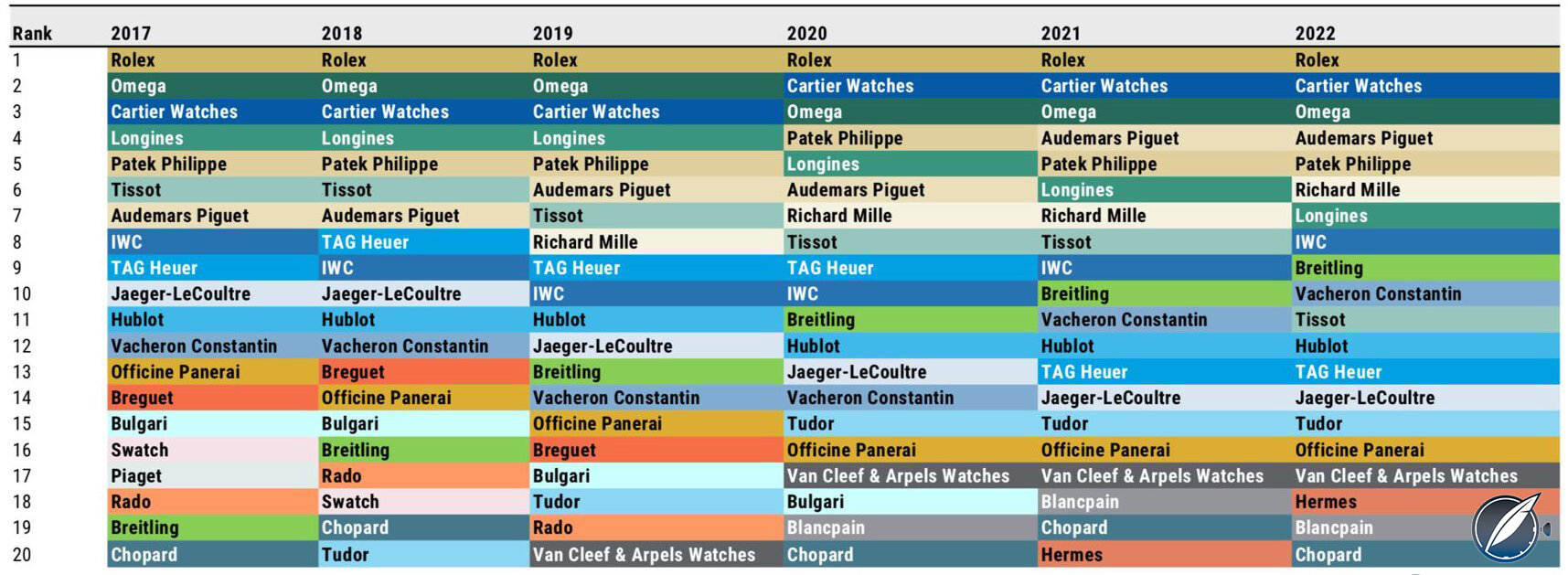
Morgan Stanley Top 20 watch brands 2017 – 2023
This rise from 19th in 2017 to 9th in 2022 is a testament to the changes Breitling has made and makes it a true success story!
Conclusion
Breitling is one of the most recognizable names in watches. Despite its rich history and iconic models, it faced headwinds both internally and externally. The brand got caught being overly complicated, both in terms of aesthetics, messaging, and changing consumer trends. The turn came in 2017 with the capital injection from CVC Capital and new management led by Georges Kern.
Since then the brand has been reformed. The collection has been simplified and downsized and a large emphasis has been placed on brand image and marketing.
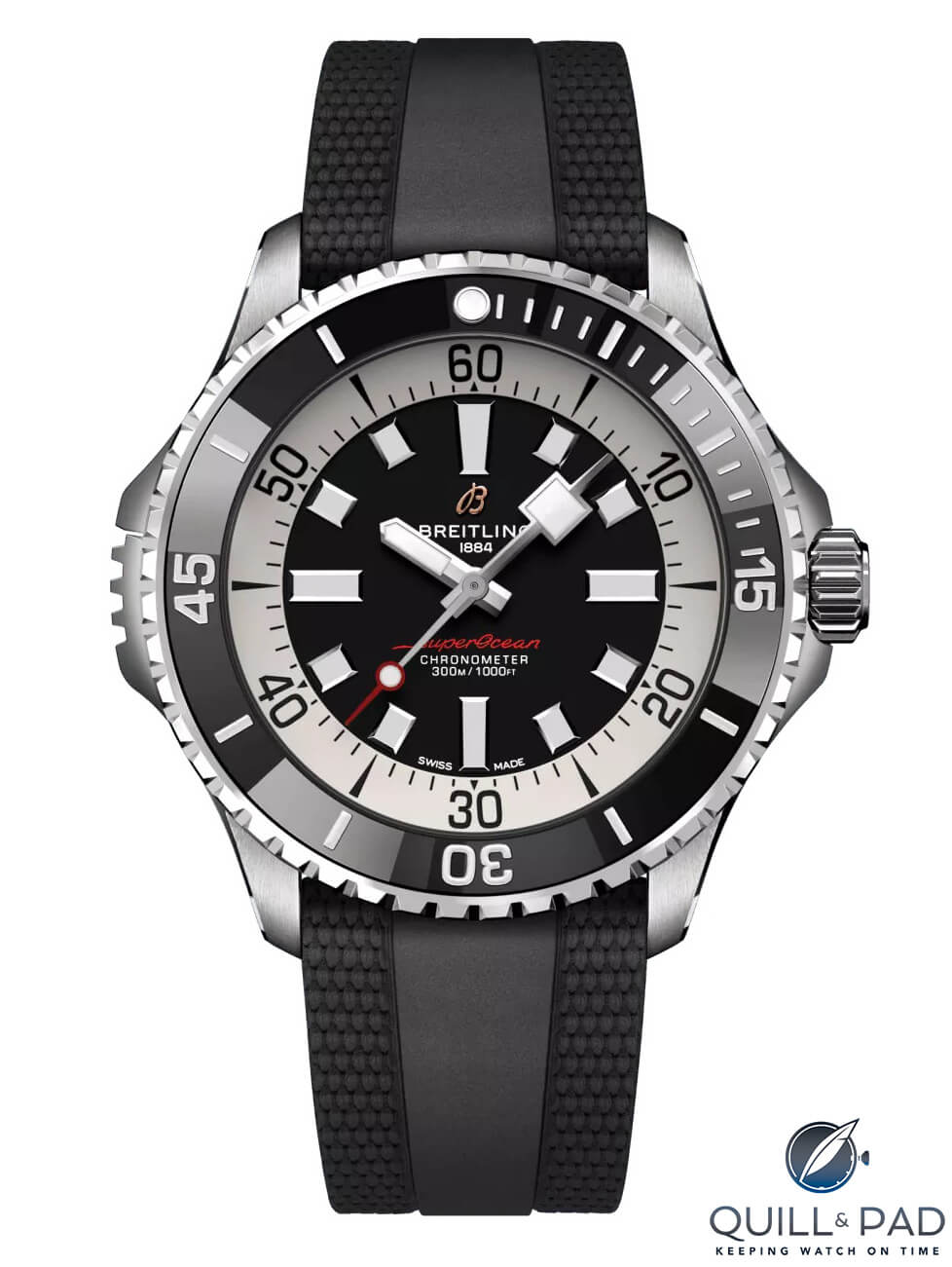
Breitling Superocean Automatic 46 mm
Kern understands the importance of emotion when it comes to buying a luxury watch and is doing a great job at conveying that. As a result, Breitling is ranked 9th by Morgan Stanley for Top Swiss Watch Brands by revenue and units sold meaning they have improved by ten ranks in the space of 5 years.
What comes next? This is a hard question as clearly, the path they have been on is working. What I think should come next is the brand continuing to look at its past to move forward. There are models such as the Co-Pilot with the two sub-dials that I find attractive and would love to see again in their collection.
Today we should appreciate the brand resurgence and the brilliance of how it has been achieved.
For more information, please visit https://www.breitling.com/
You can read more articles by Raman Kalra at www.thewatchmuse.com.
You might also enjoy:
Panerai: It’s Not Broken, But Here’s How to Fix It
Blancpain Fifty Fathoms Automatique: Time to Move on From the Rolex Submariner?
Tudor Ranger: Right Recipe But Half-Baked
Rolex Submariner vs. GMT Master II: Small Differences, Difficult Decision
Leave a Reply
Want to join the discussion?Feel free to contribute!



Dear Raman Kalra,
Great article. Please do not forget the influence here of head designer Sylvain Berneron and his team. They really know how to create the products that catch the mind of a new generation while they also pay tribute to the heritage in the right manner with the help from with super collector Fred Mandelbaum. Cheers, wouter
Hi wouter – thank you, happy you enjoyed the article!
Yes, completely appreciate the influence. They have done an outstanding job at bringing together the Breitling design language from the past into more modern, simple watches today.
Thanks, Raman
Great article. The new retail spaces appear to be a bit more at ease, which is great. As a fan of the brand, I’m pleased with Breitling’s direction. The new releases have been remarkably consistent and well-designed, thanks to an outstanding creative team. Every line that has been introduced has been an improvement over the line it has replaced. All four of the re-editions have outstanding and enthusiasts have taken notice.
There is still a bit of SKU bloat. For example, one Top Time SKU has grown to five SKUs. The Avenger and Professional lines need to be updated and streamlined. That work is certainly in progress.
Breitling’s management team has performed admirably. The year-over-year growth is probably not sustainable, which means there will eventually be turnover amongst the senior management team. As long as Sylvain Berneron and the creative team remain engaged, I have confidence in Breitling’s future.